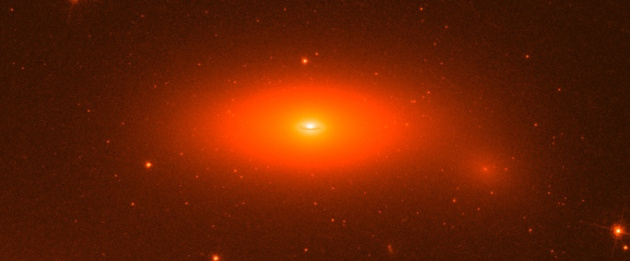The most impressive findings about the universe in 2012 (1)
The astronomical industry welcomed the impressive discoveries in 2012, which changed the way people knew about the universe, and pushed some devices to the critical level of their capabilities.
The following are the findings that made the astronomical world in 2012, according to Space.com:
The biggest black hole

Disk galaxy NGC 1277 has reached the Hubble space glass - (Photo: NASA)
Surely observers would never want to get close to the galaxy NGC 1277 of the British constellation or its central black hole, which accounts for a large part of this galaxy. That black hole is 17 billion times more massive than the sun, accounting for 14% of the total mass of the galaxy, a terrible rate compared to the usual 0.1% in most galaxies in the universe.
The large size of the black hole at first caused scientists to not believe their eyes, and they spent more than a year rechecking all the data before officially announcing it recently.
The planet is closest to Earth

Alpha Centauri star system diagram - (Photo: NASA)
In a surprising discovery, astronomers identified an Earth-sized planet in neighboring star systems. Stone planets are found at Alpha Centauri (formerly known as Southern Mon), a three-star system about 4.3 light-years away.
Life can hardly exist on the surface of Alpha Centauri Bb planet, is thought to be heated by the distance too close to the central star, 6 million km away, while the distance from the sun - Earth is 150 million kilometer.
The smallest world

Planetary System KOI-961 - (Photo: JPL-Caltech)
Astronomers used NASA's Kepler space glasses and found three tiny planets 120 light-years from Earth. Turning around, KOI-961, the smallest of these is the size of Mars, and all are smaller than Earth. Even the central star itself is not much better in size, only about 70% bigger than Jupiter.
'This is the most crowded star system ever discovered,' said John Johnson of the California Institute of Technology in Pasadena (USA).
The smallest solar system

The star system crowded together 1,100 light years from Earth - (Photo: Space.com)
KOI-500 has five planets crowded together in tight spaces, causing their gravitational force to push each other intensely during the process around the central star. The years of these planets last only 1 - 3 - 4.6 - 7.1 and 9.5 days. And yet, their size is not much higher than Earth, only about 1.3 to 2.6 times the globe.
The whole operation of the upper solar system must manage in an area that is 150 times smaller than Earth's orbit. 'With this ratio, you can easily insert 10 more planets and they are still inside the Earth's orbit,' says Darin Ragozzine, planetary scientist at the University of Florida in Gainesville (USA).
The farthest galaxy

HUDF 2012 - (Photo: NASA)
Just like the world record on the 100 meter speed track, the farthest galaxy record always changes over time. The galaxy that is filled with hope for this title is now UDFj-39546284, pictured when the new universe is 380 million years old. Its age has been confirmed in 2012 thanks to new data provided by Hubble.
The galaxy belongs to a group of seven galaxies that experts expertly surveyed, probably formed 400 to 600 million years from the Big Bang event that created the universe 13.7 billion years ago.
The new image of Hubble Ultra Deep Field (HUDF) in 2012 revealed the previously undiscovered location of the seven galaxies.
The farthest supernova explosion

The galaxy contains a supernova explosion at the time of the universe - (Photo: Swinburne University)
In 2012, astronomers described a phenomenon that they later claimed to be the earliest and earliest supernova explosions, with one case 10.4 billion years ago and the other 12.1. billion years.
Experts believe that some 'super-bright' supernovae come from giant stars, 100 to 250 times the mass of the sun. They exploded and launched material into space for billions of years ago.
- The most impressive findings about the universe in 2012 (2)
- 10 most impressive findings in 2010
- Impressive cosmic images in the month
- Photo of the impressive universe last week
- Amazing universe through the most impressive photos of 2018
- Photo universe impressive week
- Photo of the universe: The star is 150 times brighter than the Sun.
- Discovering the universe 'most lonely' universe
- Beautiful universe photos in the month
- Revealing the first fireworks photo in the universe
- Impressive astronomical photos in the month
- Beauty of the universe in the week
 Van Allen's belt and evidence that the Apollo 11 mission to the Moon was myth
Van Allen's belt and evidence that the Apollo 11 mission to the Moon was myth The levels of civilization in the universe (Kardashev scale)
The levels of civilization in the universe (Kardashev scale) Today Mars, the sun and the Earth are aligned
Today Mars, the sun and the Earth are aligned The Amazon owner announced a secret plan to build a space base for thousands of people
The Amazon owner announced a secret plan to build a space base for thousands of people World's most powerful telescope captures something that threatens to upend cosmology
World's most powerful telescope captures something that threatens to upend cosmology  'Time-traveling assassin' 13 billion years ago kills an entire galaxy
'Time-traveling assassin' 13 billion years ago kills an entire galaxy  The mystery of human lifespan limits
The mystery of human lifespan limits  13 'alien' skulls next to Mayan pyramids
13 'alien' skulls next to Mayan pyramids  How long does it take to reach another star system besides the Solar System?
How long does it take to reach another star system besides the Solar System?  For the first time, 5 super-objects from 13.6 billion years ago have been revealed.
For the first time, 5 super-objects from 13.6 billion years ago have been revealed. 